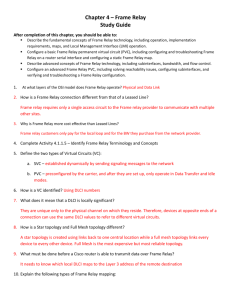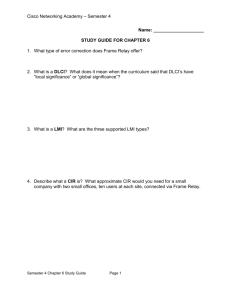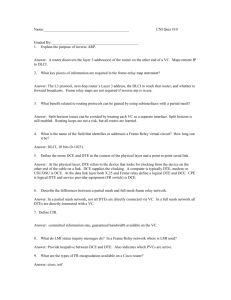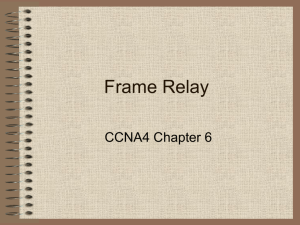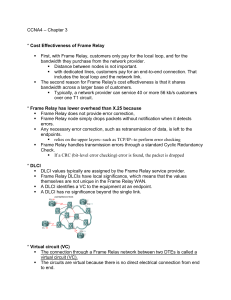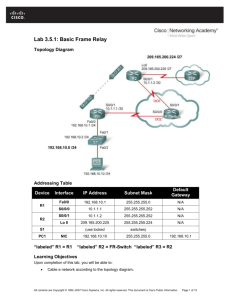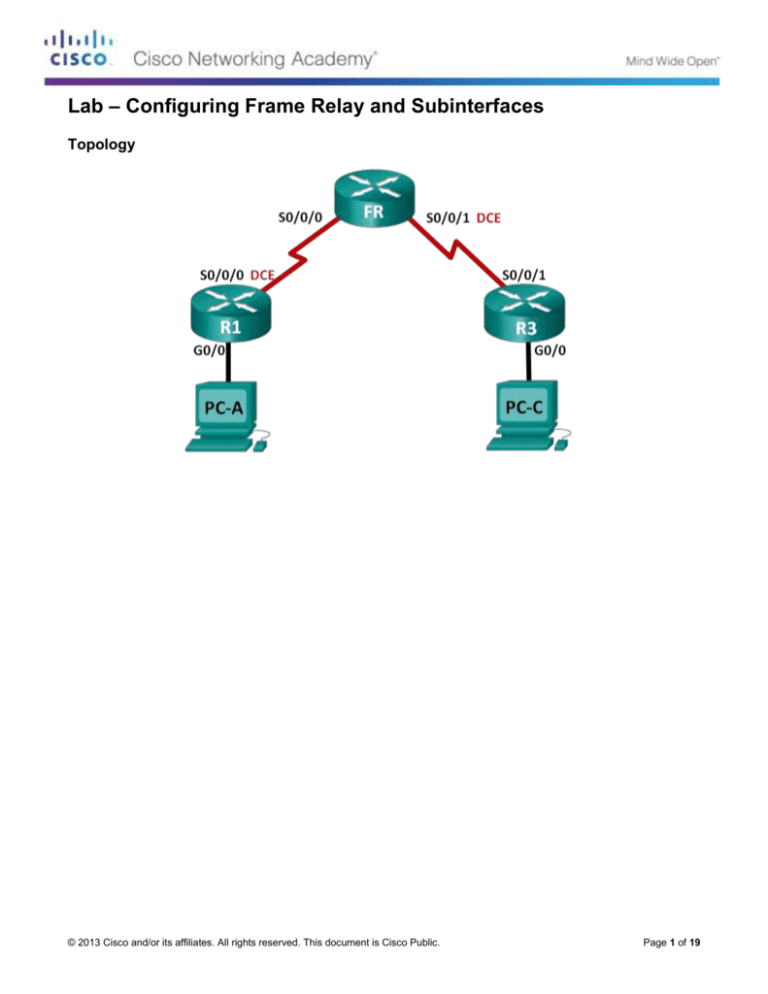
Lab – Configuring Frame Relay and Subinterfaces
Topology
© 2013 Cisco and/or its affiliates. All rights reserved. This document is Cisco Public.
Page 1 of 19
Lab – Configuring Frame Relay and Subinterfaces
Addressing Table
Device
Interface
IPv4 and IPv6 Address
Default Gateway
G0/0
192.168.1.1/24
2001:DB8:ACAD:A::1/64
FE80::1 link-local
N/A
S0/0/0 (DCE)
10.1.1.1/30
2001:DB8:ACAD:B::1/64
FE80::1 link-local
N/A
S0/0/0
N/A
N/A
S0/0/1 (DCE)
N/A
N/A
G0/0
192.168.3.1/24
2001:DB8:ACAD:C::3/64
FE80::3 link-local
N/A
S0/0/1
10.1.1.2/30
2001:DB8:ACAD:B::3/64
FE80::3 link-local
N/A
PC-A
NIC
192.168.1.3/24
2001:DB8:ACAD:A::A/64
192.168.1.1
FE80::1
PC-C
NIC
192.168.3.3/24
2001:DB8:ACAD:C::C/64
192.168.3.1
FE80::3
R1
FR
R3
Objectives
Part 1: Build the Network and Configure Basic Device Settings
Part 2: Configure a Frame Relay Switch
Part 3: Configure Basic Frame Relay
Part 4: Troubleshoot Frame Relay
Part 5: Configure a Frame Relay Subinterface
Background / Scenario
Frame Relay is a high-performance WAN protocol that operates at the physical and data link layers of the OSI
reference model. Unlike leased lines, Frame Relay requires only a single access circuit to the Frame Relay
provider to communicate with multiple sites that are connected to the same provider.
Frame Relay was one of the most extensively used WAN protocols, primarily because it was relatively
inexpensive compared to dedicated lines. In addition, configuring user equipment in a Frame Relay network is
fairly simple. With the advent of broadband services such as DSL and cable modem, GigaMAN (point-to-point
Ethernet service over fiber-optic cable), VPN, and Multiprotocol Label Switching (MPLS), Frame Relay has
become a less desirable solution for accessing the WAN. However, some rural areas do not have access to
these alternative solutions and still rely on Frame Relay for connectivity to the WAN.
In this lab, you will configure Frame Relay encapsulation on serial links. You will also configure a router to
simulate a Frame Relay switch. You will review Cisco standards and open standards that apply to Frame
Relay. You will also configure Frame Relay point-to-point subinterfaces.
© 2013 Cisco and/or its affiliates. All rights reserved. This document is Cisco Public.
Page 2 of 19
Lab – Configuring Frame Relay and Subinterfaces
Note: The routers used with CCNA hands-on labs are Cisco 1941 Integrated Services Routers (ISRs) with
Cisco IOS Release 15.2(4)M3 (universalk9 image). Other routers and Cisco IOS versions can be used.
Depending on the model and Cisco IOS version, the commands available and output produced might vary
from what is shown in the labs. Refer to the Router Interface Summary Table at the end of this lab for the
correct interface identifiers.
Note: Make sure that the routers have been erased and have no startup configurations. If you are unsure,
contact your instructor.
Required Resources
3 Routers (Cisco 1941 with Cisco IOS Release 15.2(4)M3 universal image or comparable)
2 PCs (Windows 7, Vista, or XP with terminal emulation program, such as Tera Term)
Console cables to configure the Cisco IOS devices via the console ports
Ethernet and serial cables as shown in the topology
Part 1: Build the Network and Configure Basic Device Settings
In Part 1, you will set up the network topology and configure basic settings on the PC hosts and routers.
Step 1: Cable the network as shown in the topology.
Step 2: Initialize and reload the routers as necessary.
Step 3: Configure basic settings for each router.
a. Disable DNS lookup.
b. Configure device names as shown in the topology.
c.
Assign class as the privileged EXEC mode password.
d. Assign cisco as the console and vty passwords and enable login.
e. Configure logging synchronous for the console line.
f.
Encrypt the plain text passwords.
g. Configure a MOTD banner to warn users that unauthorized access is prohibited.
h. Set the clocking rate for all DCE serial interfaces to 128000.
i.
Configure the IPv4 and IPv6 addresses listed in the Addressing Table for all interfaces. Do not activate
the serial interfaces at this time.
j.
Copy the running configuration to the startup configuration.
Step 4: Configure PC hosts.
Refer to the Addressing Table for PC host address information.
Step 5: Test connectivity.
At this point, the PCs will not be able to ping each other, but they should be able to ping their default gateway.
Test both protocols, IPv4 and IPv6. Verify and troubleshoot if necessary.
© 2013 Cisco and/or its affiliates. All rights reserved. This document is Cisco Public.
Page 3 of 19
Lab – Configuring Frame Relay and Subinterfaces
Part 2: Configure a Frame Relay Switch
In Part 2, you will configure a Frame Relay switch. You will create permanent virtual circuits (PVCs) and
assign Data Link Connection Identifiers (DLCIs). This configuration creates two PVCs: one from R1 to R3
(DLCI 103), and one from R3 to R1 (DLCI 301).
Step 1: Configure the FR router as a Frame Relay switch.
The frame-relay switching command enables Frame Relay switching globally on a router, allowing it to
forward frames based on the incoming DLCI rather than an IP address.
FR(config)# frame-relay switching
Step 2: Change the interface encapsulation on S0/0/0.
Change the interface encapsulation type to Frame Relay. Like HDLC or PPP, Frame Relay is a data-link layer
protocol that specifies the framing of Layer 2 traffic.
FR(config)# interface s0/0/0
FR(config-if)# encapsulation frame-relay
Step 3: Change the interface type to DCE.
Changing the interface type to DCE tells the router to send Local Management Interface (LMI) keepalives and
allows Frame Relay route statements to be applied.
Note: Frame Relay interface types do not need to match the underlying physical interface type. A physical
DTE serial interface can act as a Frame Relay DCE interface, and a physical DCE interface can act as a
logical Frame Relay DTE interface.
FR(config)# interface s0/0/0
FR(config-if)# frame-relay intf-type dce
Step 4: Configure DLCI.
Configure the router to forward incoming traffic on interface S0/0/0 with DLCI 103 to S0/0/1 with an output of
DLCI of 301.
FR(config-if)# frame-relay route 103 interface s0/0/1 301
FR(config-if)# no shutdown
Step 5: Configure Frame Relay on S0/0/1.
FR(config)# interface s0/0/1
FR(config-if)# encapsulation frame-relay
FR(config-if)# frame-relay intf-type dce
FR(config-if)# frame-relay route 301 interface s0/0/0 103
FR(config-if)# no shutdown
Step 6: Verify Frame Relay configuration.
a. Use the show frame-relay pvc command to verify that Frame Relay is configured correctly.
FR# show frame-relay pvc
PVC Statistics for interface Serial0/0/0 (Frame Relay DCE)
© 2013 Cisco and/or its affiliates. All rights reserved. This document is Cisco Public.
Page 4 of 19
Lab – Configuring Frame Relay and Subinterfaces
Local
Switched
Unused
Active
0
0
0
Inactive
0
1
0
Deleted
0
0
0
Static
0
0
0
DLCI = 103, DLCI USAGE = SWITCHED, PVC STATUS = INACTIVE, INTERFACE = Serial0/0/0
input pkts 0
output pkts 0
in bytes 0
out bytes 0
dropped pkts 0
in pkts dropped 0
out pkts dropped 0
out bytes dropped 0
in FECN pkts 0
in BECN pkts 0
out FECN pkts 0
out BECN pkts 0
in DE pkts 0
out DE pkts 0
out bcast pkts 0
out bcast bytes 0
30 second input rate 0 bits/sec, 0 packets/sec
30 second output rate 0 bits/sec, 0 packets/sec
switched pkts 0
Detailed packet drop counters:
no out intf 0
out intf down 0
no out PVC 0
in PVC down 0
out PVC down 0
pkt too big 0
shaping Q full 0
pkt above DE 0
policing drop 0
connected to interface Serial0/0/1 301
pvc create time 00:00:53, last time pvc status changed 00:00:53
PVC Statistics for interface Serial0/0/1 (Frame Relay DCE)
Local
Switched
Unused
Active
0
0
0
Inactive
0
1
0
Deleted
0
0
0
Static
0
0
0
DLCI = 301, DLCI USAGE = SWITCHED, PVC STATUS = INACTIVE, INTERFACE = Serial0/0/1
input pkts 0
output pkts 0
in bytes 0
out bytes 0
dropped pkts 0
in pkts dropped 0
out pkts dropped 0
out bytes dropped 0
in FECN pkts 0
in BECN pkts 0
out FECN pkts 0
out BECN pkts 0
in DE pkts 0
out DE pkts 0
out bcast pkts 0
out bcast bytes 0
30 second input rate 0 bits/sec, 0 packets/sec
30 second output rate 0 bits/sec, 0 packets/sec
switched pkts 0
Detailed packet drop counters:
no out intf 0
out intf down 0
no out PVC 0
in PVC down 0
out PVC down 0
pkt too big 0
shaping Q full 0
pkt above DE 0
policing drop 0
connected to interface Serial0/0/0 103
pvc create time 00:00:16, last time pvc status changed 00:00:16
b. Issue the show frame-relay route command. This is the Layer 2 route that Frame Relay traffic takes
through the network. (Do not confuse this with Layer 3 IP routing.)
© 2013 Cisco and/or its affiliates. All rights reserved. This document is Cisco Public.
Page 5 of 19
Lab – Configuring Frame Relay and Subinterfaces
FR# show frame-relay route
Input Intf
Serial0/0/0
Serial0/0/1
Input Dlci
103
301
Output Intf
Serial0/0/1
Serial0/0/0
Output Dlci
301
103
Status
inactive
inactive
Part 3: Configure Basic Frame Relay
In Part 3, you will configure Frame Relay on routers R1 and R3. After Frame Relay is configured, you will
enable the EIGRP routing protocol to provide end-to-end connectivity.
Step 1: Configure R1 for Frame Relay.
Inverse ARP allows distant ends of a Frame Relay link to discover each other dynamically, and provides a
dynamic method of mapping IP addresses to DLCIs. Although Inverse ARP is useful, it is not always reliable.
The best practice is to map IP addresses to DLCIs statically and disable Inverse ARP.
a. Change the encapsulation on S0/0/0 to Frame Relay.
R1(config)# interface s0/0/0
R1(config-if)# encapsulation frame-relay
b. Use the no frame-relay inverse-arp command to disable Inverse ARP.
R1(config)# interface s0/0/0
R1(config-if)# no frame-relay inverse-arp
c.
Use the frame-relay map command to map an IP address to a DLCI statically. In addition to mapping an
IP to a DLCI, Cisco IOS software allows several other Layer 3 protocol addresses to be mapped. In the
following command, the broadcast keyword sends any multicast or broadcast traffic destined for this link
over the DLCI. Most routing protocols require the broadcast keyword to function properly over Frame
Relay. You can use the broadcast keyword on multiple DLCIs on the same interface. The traffic is
replicated to all PVCs.
Note: The IPv6 Frame Relay map to a global unicast address does not include the broadcast keyword.
However, the broadcast keyword is used in the mapping to the link-local address. IPv6 routing protocols
use link-local addresses for multicast routing updates; therefore, only the link-local address map requires
the broadcast keyword to forward multicast packets.
R1(config)# interface s0/0/0
R1(config-if)# frame-relay map ip 10.1.1.2 103 broadcast
R1(config-if)# frame-relay map ipv6 2001:db8:acad:b::3 103
R1(config-if)# frame-relay map ipv6 fe80::3 103 broadcast
d. For the router to ping its own interface, the DLCI must be created to map to the local interface.
R1(config)# interface s0/0/0
R1(config-if)# frame-relay map ip 10.1.1.1 103
R1(config-if)# frame-relay map ipv6 2001:db8:acad:b::1 103
e. Use the no shutdown command to activate S0/0/0.
R1(config-if)# no shutdown
Step 2: Configure R3 for Frame Relay.
R3(config)# interface s0/0/1
R3(config-if)# encapsulation frame-relay
R3(config-if)# no frame-relay inverse-arp
© 2013 Cisco and/or its affiliates. All rights reserved. This document is Cisco Public.
Page 6 of 19
Lab – Configuring Frame Relay and Subinterfaces
R3(config-if)#
R3(config-if)#
R3(config-if)#
R3(config-if)#
R3(config-if)#
R3(config-if)#
frame-relay
frame-relay
frame-relay
frame-relay
frame-relay
no shutdown
map
map
map
map
map
ip 10.1.1.1 301 broadcast
ipv6 2001:db8:acad:b::1 301
ipv6 fe80::1 301 broadcast
ip 10.1.1.2 301
ipv6 2001:db8:acad:b::3 301
Why is the no shutdown command used after the no frame-relay inverse-arp command?
_______________________________________________________________________________________
_______________________________________________________________________________________
_______________________________________________________________________________________
_______________________________________________________________________________________
Step 3: Verify that Frame Relay is active.
a. You should now be able to ping R3 from R1. It may take several seconds after bringing up the interfaces
for the PVCs to become active.
R1# ping 10.1.1.2
Type escape sequence to abort.
Sending 5, 100-byte ICMP Echos to 10.1.1.2, timeout is 2 seconds:
!!!!!
Success rate is 100 percent (5/5), round-trip min/avg/max = 28/30/40 ms
R1# ping 2001:db8:acad:b::3
Type escape sequence to abort.
Sending 5, 100-byte ICMP Echos to 2001:DB8:ACAD:B::3, timeout is 2 seconds:
!!!!!
Success rate is 100 percent (5/5), round-trip min/avg/max = 28/28/28 ms
b. Ping R1 from R3.
R3# ping 10.1.1.1
Type escape sequence to abort.
Sending 5, 100-byte ICMP Echos to 10.1.1.1, timeout is 2 seconds:
!!!!!
Success rate is 100 percent (5/5), round-trip min/avg/max = 28/28/28 ms
R3# ping 2001:db8:acad:b::1
Type escape sequence to abort.
Sending 5, 100-byte ICMP Echos to 2001:DB8:ACAD:B::1, timeout is 2 seconds:
!!!!!
Success rate is 100 percent (5/5), round-trip min/avg/max = 24/26/28 ms
c.
Issue the show frame-relay pvc command to display PVC status information on R1 and R3.
R1# show frame-relay pvc
PVC Statistics for interface Serial0/0/0 (Frame Relay DTE)
Local
Switched
Unused
Active
1
0
0
Inactive
0
0
0
Deleted
0
0
0
© 2013 Cisco and/or its affiliates. All rights reserved. This document is Cisco Public.
Static
0
0
0
Page 7 of 19
Lab – Configuring Frame Relay and Subinterfaces
DLCI = 103, DLCI USAGE = LOCAL, PVC STATUS = ACTIVE, INTERFACE = Serial0/0/0
input pkts 22
output pkts 154
in bytes 2240
out bytes 10860
dropped pkts 0
in pkts dropped 0
out pkts dropped 0
out bytes dropped 0
in FECN pkts 0
in BECN pkts 0
out FECN pkts 0
out BECN pkts 0
in DE pkts 0
out DE pkts 0
out bcast pkts 134
out bcast bytes 8780
5 minute input rate 0 bits/sec, 0 packets/sec
5 minute output rate 0 bits/sec, 0 packets/sec
pvc create time 01:59:40, last time pvc status changed 01:55:14
R3# show frame-relay pvc
PVC Statistics for interface Serial0/0/1 (Frame Relay DTE)
Local
Switched
Unused
Active
1
0
0
Inactive
0
0
0
Deleted
0
0
0
Static
0
0
0
DLCI = 301, DLCI USAGE = LOCAL, PVC STATUS = ACTIVE, INTERFACE = Serial0/0/1
input pkts 158
output pkts 22
in bytes 11156
out bytes 2240
dropped pkts 0
in pkts dropped 0
out pkts dropped 0
out bytes dropped 0
in FECN pkts 0
in BECN pkts 0
out FECN pkts 0
out BECN pkts 0
in DE pkts 0
out DE pkts 0
out bcast pkts 2
out bcast bytes 160
5 minute input rate 0 bits/sec, 0 packets/sec
5 minute output rate 0 bits/sec, 0 packets/sec
pvc create time 01:57:20, last time pvc status changed 01:56:19
d. Issue the show frame-relay route command on FR to verify that status of the Frame Relay map
statements.
FR# show frame-relay route
Input Intf
Serial0/0/0
Serial0/0/1
Input Dlci
103
301
Output Intf
Serial0/0/1
Serial0/0/0
Output Dlci
301
103
Status
active
active
e. Issue the show frame-relay map command on R1 and R3 to display a summary of the static and
dynamic mappings of Layer 3 addresses to DLCIs. Because Inverse ARP has been turned off, there are
only static maps.
R1# show frame-relay map
Serial0/0/0 (up): ipv6 FE80::3 dlci 103(0x67,0x1870), static,
broadcast,
CISCO, status defined, active
Serial0/0/0 (up): ipv6 2001:DB8:ACAD:B::1 dlci 103(0x67,0x1870), static,
CISCO, status defined, active
© 2013 Cisco and/or its affiliates. All rights reserved. This document is Cisco Public.
Page 8 of 19
Lab – Configuring Frame Relay and Subinterfaces
Serial0/0/0 (up): ip 10.1.1.1 dlci 103(0x67,0x1870), static,
CISCO, status defined, active
Serial0/0/0 (up): ipv6 2001:DB8:ACAD:B::3 dlci 103(0x67,0x1870), static,
CISCO, status defined, active
Serial0/0/0 (up): ip 10.1.1.2 dlci 103(0x67,0x1870), static,
broadcast,
CISCO, status defined, active
R3# show frame-relay map
Serial0/0/1 (up): ipv6 FE80::1 dlci 301(0x12D,0x48D0), static,
broadcast,
CISCO, status defined, active
Serial0/0/1 (up): ipv6 2001:DB8:ACAD:B::3 dlci 301(0x12D,0x48D0), static,
CISCO, status defined, active
Serial0/0/1 (up): ip 10.1.1.2 dlci 301(0x12D,0x48D0), static,
CISCO, status defined, active
Serial0/0/1 (up): ipv6 2001:DB8:ACAD:B::1 dlci 301(0x12D,0x48D0), static,
CISCO, status defined, active
Serial0/0/1 (up): ip 10.1.1.1 dlci 301(0x12D,0x48D0), static,
broadcast,
CISCO, status defined, active
Note: The FR router acts as a Layer 2 device, so there is no need to map Layer 3 addresses to Layer 2
DLCIs.
Step 4: Configure EIGRP on R1 and R3.
a. Enable IPv6 routing on R1 and R3.
b. Using AS 1, enable EIGRP for IPv4 and IPv6 on R1 and R3 for all networks. Set the router ID for R1 as
1.1.1.1 and 3.3.3.3 for R3.
Step 5: Verify end-to-end connectivity.
Ping PC-C from PC-A. If your pings were unsuccessful, troubleshoot until you have end-to-end connectivity.
Note: It may be necessary to disable the PC firewall for pings to be successful.
Part 4: Troubleshoot Frame Relay
In Part 4, you will break the Frame Relay connection established earlier and use some tools to troubleshoot
Frame Relay. A variety of tools are available for troubleshooting Frame Relay connectivity issues.
Step 1: Debug Local Management Interface (LMI).
a. Issue the debug frame-relay lmi command on R1. The output gives detailed information on all LMI data.
Keepalives are sent every 10 seconds by default, so you may have to wait until you see any output. The
output shows an outgoing LMI packet with a sequence number of 50. The last LMI message received
from FR had a sequence number of 49. The output is also showing an incoming LMI message from FR to
R1 with a sequence number of 50. DLCI 103 is the only DLCI on this link, and it is currently active.
R1# debug frame-relay lmi
Frame Relay LMI debugging is on
Displaying all Frame Relay LMI data
R1#
© 2013 Cisco and/or its affiliates. All rights reserved. This document is Cisco Public.
Page 9 of 19
Lab – Configuring Frame Relay and Subinterfaces
*Jun
*Jun
*Jun
*Jun
*Jun
*Jun
*Jun
*Jun
*Jun
26
26
26
26
26
26
26
26
26
18:28:45.922:
18:28:45.922:
18:28:45.922:
18:28:45.922:
18:28:45.922:
18:28:45.922:
18:28:45.922:
18:28:45.922:
18:28:45.922:
Serial0/0/0(out): StEnq, myseq 50, yourseen 49, DTE up
datagramstart = 0xC318D54, datagramsize = 13
FR encap = 0xFCF10309
00 75 01 01 01 03 02 32 31
Serial0/0/0(in): Status, myseq 50, pak size 13
RT IE 1, length 1, type 1
KA IE 3, length 2, yourseq 50, myseq 50
PVC IE 0x7 , length 0x6 , dlci 103 , status 0x2 , bw 0
b. Issue the undebug all command to turn off debugging.
Note: This command can be abbreviated to u all. This is useful to know when debug information is
flooding the screen.
R1# undebug all
All possible debugging has been turned off
Step 2: Remove the IPv4 frame map from R1.
a. Issue the no frame-relay map command to remove the IPv4 frame map on R1.
R1(config)# interface s0/0/0
R1(config-if)# no frame-relay map ip 10.1.1.2 103 broadcast
b. Issue the debug ip icmp command on R1.
R1# debug ip icmp
ICMP packet debugging is on
c.
Ping R1 from R3. Pings should not be successful. However, debug messages on R1 show that the ICMP
packets from R3 are reaching R1.
Note: You should see console messages reporting the EIGRP adjacency going up and down. This is
sometimes called flapping.
R3# ping 10.1.1.1
Type escape sequence to abort.
Sending 5, 100-byte ICMP Echos to 10.1.1.1, timeout is 2 seconds:
.....
Success rate is 0 percent (0/5)
R1#
*Jun 26 20:12:35.693:
BASE, dscp 0 topoid 0
R1#
*Jun 26 20:12:37.689:
BASE, dscp 0 topoid 0
R1#
*Jun 26 20:12:39.689:
BASE, dscp 0 topoid 0
R1#
*Jun 26 20:12:41.689:
BASE, dscp 0 topoid 0
R1#
*Jun 26 20:12:43.689:
BASE, dscp 0 topoid 0
ICMP: echo reply sent, src 10.1.1.1, dst 10.1.1.2, topology
ICMP: echo reply sent, src 10.1.1.1, dst 10.1.1.2, topology
ICMP: echo reply sent, src 10.1.1.1, dst 10.1.1.2, topology
ICMP: echo reply sent, src 10.1.1.1, dst 10.1.1.2, topology
ICMP: echo reply sent, src 10.1.1.1, dst 10.1.1.2, topology
© 2013 Cisco and/or its affiliates. All rights reserved. This document is Cisco Public.
Page 10 of 19
Lab – Configuring Frame Relay and Subinterfaces
Why does the ping fail?
____________________________________________________________________________________
____________________________________________________________________________________
d. Issue the show frame-relay map command on R1. The IPv4 map for R3 is missing from the list.
R1# show frame-relay map
Serial0/0/0 (up): ipv6 FE80::3 dlci 103(0x67,0x1870), static,
broadcast,
CISCO, status defined, active
Serial0/0/0 (up): ipv6 2001:DB8:ACAD:B::1 dlci 103(0x67,0x1870), static,
CISCO, status defined, active
Serial0/0/0 (up): ip 10.1.1.1 dlci 103(0x67,0x1870), static,
CISCO, status defined, active
Serial0/0/0 (up): ipv6 2001:DB8:ACAD:B::3 dlci 103(0x67,0x1870), static,
CISCO, status defined, active
e. Issue the undebug all command to turn off debugging on R1.
R1# undebug all
All possible debugging has been turned off
f.
Re-apply the frame-relay map ip command to S0/0/0 on R1, but without using the broadcast keyword.
R1(config)# interface s0/0/0
R1(config-if)# frame-relay map ip 10.1.1.2 103
g. Ping R1 from R3. Pings should be successful, but the EIGRP adjacency continues to flap. It may take a
few minutes between each message because of the EIGRP timers.
R3# ping 10.1.1.1
Type escape sequence to abort.
Sending 5, 100-byte ICMP Echos to 10.1.1.1, timeout is 2 seconds:
!!!!!
Success rate is 100 percent (5/5), round-trip min/avg/max = 28/28/28 ms
R1(config-if)#
*Jun 26 20:25:10.871: %DUAL-5-NBRCHANGE: EIGRP-IPv4
is down: Interface PEER-TERMINATION received
*Jun 26 20:28:13.673: %DUAL-5-NBRCHANGE: EIGRP-IPv4
is up: new adjacency
R1(config-if)#
*Jun 26 20:31:18.185: %DUAL-5-NBRCHANGE: EIGRP-IPv4
is down: retry limit exceeded
R1(config-if)#
*Jun 26 20:32:00.977: %DUAL-5-NBRCHANGE: EIGRP-IPv4
is up: new adjacency
R1(config-if)#
*Jun 26 20:35:05.489: %DUAL-5-NBRCHANGE: EIGRP-IPv4
is down: retry limit exceeded
1: Neighbor 10.1.1.2 (Serial0/0/0)
1: Neighbor 10.1.1.2 (Serial0/0/0)
1: Neighbor 10.1.1.2 (Serial0/0/0)
1: Neighbor 10.1.1.2 (Serial0/0/0)
1: Neighbor 10.1.1.2 (Serial0/0/0)
Why does the EIGRP adjacency continue to flap?
____________________________________________________________________________________
____________________________________________________________________________________
© 2013 Cisco and/or its affiliates. All rights reserved. This document is Cisco Public.
Page 11 of 19
Lab – Configuring Frame Relay and Subinterfaces
h. Replace the Frame Relay map statement and include the broadcast keyword this time.
R1(config-if)# frame-relay map ip 10.1.1.2 103 broadcast
i.
Verify that the full routing table is restored and that you have end-to-end connectivity.
Step 3: Change the Frame Relay encapsulation type.
Cisco IOS software supports two types of Frame Relay encapsulation: the default Cisco encapsulation and
the standards-based IETF encapsulation.
a. Change the Frame Relay encapsulation on S0/0/1 on R3 to IETF.
R3(config)# interface s0/0/1
R3(config-if)# encapsulation frame-relay ietf
b. Issue the show interfaces s0/0/1 command on R3 and FR. Even though the encapsulation is different on
each interface, the link is still active. This is because Cisco routers understand both types of incoming
frames. However, if you have routers from different vendors and you are using Frame Relay, then the
IETF standard must be used.
R3# show interfaces s0/0/1
Serial0/0/1 is up, line protocol is up
Hardware is WIC MBRD Serial
Internet address is 10.1.1.2/30
MTU 1500 bytes, BW 1544 Kbit/sec, DLY 20000 usec,
reliability 255/255, txload 1/255, rxload 1/255
Encapsulation FRAME-RELAY IETF, loopback not set
Keepalive set (10 sec)
LMI enq sent 1898, LMI stat recvd 1900, LMI upd recvd 0, DTE LMI up
<output omitted>
FR# show interfaces s0/0/1
Serial0/0/1 is up, line protocol is up
Hardware is WIC MBRD Serial
MTU 1500 bytes, BW 1544 Kbit/sec, DLY 20000 usec,
reliability 255/255, txload 1/255, rxload 1/255
Encapsulation FRAME-RELAY, loopback not set
Keepalive set (10 sec)
LMI enq sent 0, LMI stat recvd 0, LMI upd recvd 0
c.
Reset the R3 Frame Relay encapsulation back to Cisco (the default).
R3(config)# interface s0/0/1
R3(config-if)# encapsulation frame-relay
Step 4: Change the LMI type.
a. Issue the frame-relay lmi-type ansi command on interface S0/0/1 on R3.
R3(config-if)# frame-relay lmi-type ansi
b. After at least 60 seconds, issue the show interfaces s0/0/1 command on R3. When 60 seconds have
passed, the interface changes its state to up, then down, because R3 is expecting ANSI LMI, and FR is
sending Cisco LMI.
R3# show interfaces s0/0/1
Serial0/0/1 is up, line protocol is down
© 2013 Cisco and/or its affiliates. All rights reserved. This document is Cisco Public.
Page 12 of 19
Lab – Configuring Frame Relay and Subinterfaces
Hardware is WIC MBRD Serial
Internet address is 10.1.1.2/30
MTU 1500 bytes, BW 1544 Kbit/sec, DLY 20000 usec,
reliability 255/255, txload 1/255, rxload 1/255
Encapsulation FRAME-RELAY, loopback not set
Keepalive set (10 sec)
LMI enq sent 2157, LMI stat recvd 2136, LMI upd recvd 0, DTE LMI down
LMI enq recvd 0, LMI stat sent 0, LMI upd sent 0
LMI DLCI 0 LMI type is ANSI Annex D frame relay DTE segmentation inactive
FR SVC disabled, LAPF state down
Broadcast queue 0/64, broadcasts sent/dropped 733/0, interface broadcast
<output omitted>
c.
On R3, issue the show frame-relay lmi command to display LMI information, including LMI type, number
of timeouts, and the amount of time since the last full update.
R3# show frame-relay lmi
LMI Statistics for interface Serial0/0/1 (Frame Relay DTE) LMI TYPE = ANSI
Invalid Unnumbered info 0
Invalid Prot Disc 0
Invalid dummy Call Ref 0
Invalid Msg Type 0
Invalid Status Message 0
Invalid Lock Shift 0
Invalid Information ID 0
Invalid Report IE Len 0
Invalid Report Request 0
Invalid Keep IE Len 0
Num Status Enq. Sent 2158
Num Status msgs Rcvd 2136
Num Update Status Rcvd 0
Num Status Timeouts 23
Last Full Status Req 00:00:05
Last Full Status Rcvd 00:04:35
d. On R3, issue the debug frame-relay lmi command. The LMI packets no longer display in pairs. While all
outgoing LMI messages are logged, no incoming messages display because R3 is expecting ANSI LMI,
and FR is sending Cisco LMI.
R3# debug frame-relay lmi
Frame Relay LMI debugging is on
Displaying all Frame Relay LMI data
R3#
*Jun 26 21:49:10.829: Serial0/0/1(out): StEnq, myseq 104, yourseen 0, DTE down
*Jun 26 21:49:10.829: datagramstart = 0xC313554, datagramsize = 14
*Jun 26 21:49:10.829: FR encap = 0x00010308
*Jun 26 21:49:10.829: 00 75 95 01 01 00 03 02 68 00
*Jun 26 21:49:10.829:
R3#
*Jun 26 21:49:20.829: Serial0/0/1(out): StEnq, myseq 105, yourseen 0, DTE down
*Jun 26 21:49:20.829: datagramstart = 0xC317554, datagramsize = 14
*Jun 26 21:49:20.829: FR encap = 0x00010308
*Jun 26 21:49:20.829: 00 75 95 01 01 00 03 02 69 00
*Jun 26 21:49:20.829:
e. Restore the LMI type back to Cisco on R3. Notice that the debug messages change after you issue this
command. The LMI sequence number has been reset to 1. R3 began to understand the LMI messages
coming in from FR. After R3 and FR have successfully exchanged LMI messages, the interface changed
state to up.
© 2013 Cisco and/or its affiliates. All rights reserved. This document is Cisco Public.
Page 13 of 19
Lab – Configuring Frame Relay and Subinterfaces
R3(config)# interface s0/0/1
R3(config-if)# frame-relay lmi-type cisco
R3(config-if)#
*Jun 26 21:51:20.829: Serial0/0/1(out): StEnq, myseq 117, yourseen 0, DTE down
*Jun 26 21:51:20.829: datagramstart = 0xC31F254, datagramsize = 14
*Jun 26 21:51:20.829: FR encap = 0x00010308
*Jun 26 21:51:20.829: 00 75 95 01 01 00 03 02 75 00
*Jun 26 21:51:20.829:
R3(config-if)#
*Jun 26 21:51:30.829: Serial0/0/1(out): StEnq, myseq 1, yourseen 0, DTE down
*Jun 26 21:51:30.829: datagramstart = 0xC31F3D4, datagramsize = 13
*Jun 26 21:51:30.829: FR encap = 0xFCF10309
*Jun 26 21:51:30.829: 00 75 01 01 00 03 02 01 00
*Jun 26 21:51:30.829:
*Jun 26 21:51:30.829: Serial0/0/1(in): Status, myseq 1, pak size 21
*Jun 26 21:51:30.829: RT IE 1, length 1, type 0
*Jun 26 21:51:30.829: KA IE 3, length 2, yourseq 1 , myseq 1
*Jun 26 21:51:30.829: PVC IE 0x7 , length 0x6 , dlci 301, stat
R3(config-if)#us 0x2 , bw 0
R3(config-if)#
*Jun 26 21:51:40.829: Serial0/0/1(out): StEnq, myseq 2, yourseen 1, DTE down
*Jun 26 21:51:40.829: datagramstart = 0xC313B54, datagramsize = 13
*Jun 26 21:51:40.829: FR encap = 0xFCF10309
*Jun 26 21:51:40.829: 00 75 01 01 01 03 02 02 01
*Jun 26 21:51:40.829:
*Jun 26 21:51:40.829: Serial0/0/1(in): Status, myseq 2, pak size 21
*Jun 26 21:51:40.829: RT IE 1, length 1, type 0
*Jun 26 21:51:40.829: KA IE 3, length 2, yourseq 2 , myseq 2
*Jun 26 21:51:40.829: PVC IE 0x7 , length 0x6 , dlci 301, stat
R3(config-if)#us 0x2 , bw 0
*Jun 26 21:51:51.829: %LINEPROTO-5-UPDOWN: Line protocol on Interface
Serial0/0/1, changed state to up
R3(config-if)#
f.
Issue the undebug all command to end debugging.
R3# undebug all
All possible debugging has been turned off
Part 5: Configure a Frame Relay Subinterface
Frame Relay supports two types of subinterfaces: point-to-point and point-to-multipoint. Point-to-multipoint
subinterfaces support non-broadcast multiaccess topologies. For example, a hub and spoke topology would
use a point-to-multipoint subinterface. In Part 5, you will create a point-to-point subinterface.
Step 1: On the FR router, create new PVCs between R1 and R3.
FR(config)# interface s0/0/0
FR(config-if)# frame-relay route 113 interface s0/0/1 311
FR(config-if)# interface s0/0/1
FR(config-if)# frame-relay route 311 interface s0/0/0 113
© 2013 Cisco and/or its affiliates. All rights reserved. This document is Cisco Public.
Page 14 of 19
Lab – Configuring Frame Relay and Subinterfaces
Step 2: Create and configure a point-to-point subinterface on R1 and R3.
Note: Frame Relay encapsulation must be specified on the physical interface before subinterfaces can be
created.
a. Create subinterface 113 as a point-to-point interface on R1.
R1(config)# interface s0/0/0.113 point-to-point
R1(config-subif)# ip address 10.1.1.5 255.255.255.252
R1(config-subif)# ipv6 address 2001:db8:acad:d::1/64
R1(config-subif)# ipv6 address fe80::1 link-local
R1(config-subif)# frame-relay interface-dlci 113
R1(config-fr-dlci)#
b. Create subinterface 311 as a point-to-point subinterface on R3.
R3(config)# interface s0/0/1.311 point-to-point
R3(config-subif)# ip address 10.1.1.6 255.255.255.252
R3(config-subif)# ipv6 address 2001:db8:acad:d::3/64
R3(config-subif)# ipv6 address fe80::3 link-local
R3(config-subif)# frame-relay interface-dlci 311
R3(config-fr-dlci)#
c.
Verify connectivity.
R1# ping 10.1.1.6
Type escape sequence to abort.
Sending 5, 100-byte ICMP Echos to 10.1.1.6, timeout is 2 seconds:
!!!!!
Success rate is 100 percent (5/5), round-trip min/avg/max = 28/28/28 ms
R1# ping 2001:db8:acad:d::3
Type escape sequence to abort.
Sending 5, 100-byte ICMP Echos to 2001:DB8:ACAD:D::3, timeout is 2 seconds:
!!!!!
Success rate is 100 percent (5/5), round-trip min/avg/max = 28/28/28 ms
R3# ping 10.1.1.5
Type escape sequence to abort.
Sending 5, 100-byte ICMP Echos to 10.1.1.5, timeout is 2 seconds:
!!!!!
Success rate is 100 percent (5/5), round-trip min/avg/max = 28/28/28 ms
R3# ping 2001:db8:acad:d::1
Type escape sequence to abort.
Sending 5, 100-byte ICMP Echos to 2001:DB8:ACAD:D::1, timeout is 2 seconds:
!!!!!
Success rate is 100 percent (5/5), round-trip min/avg/max = 28/28/28 ms
d. Issue the show frame-relay pvc command on R1 and R3 to display the PVC status.
R1# show frame-relay pvc
PVC Statistics for interface Serial0/0/0 (Frame Relay DTE)
© 2013 Cisco and/or its affiliates. All rights reserved. This document is Cisco Public.
Page 15 of 19
Lab – Configuring Frame Relay and Subinterfaces
Local
Switched
Unused
Active
2
0
0
Inactive
0
0
0
Deleted
0
0
0
Static
0
0
0
DLCI = 103, DLCI USAGE = LOCAL, PVC STATUS = ACTIVE, INTERFACE = Serial0/0/0
input pkts 1170
output pkts 1408
in bytes 92566
out bytes 105327
dropped pkts 0
in pkts dropped 0
out pkts dropped 0
out bytes dropped 0
in FECN pkts 0
in BECN pkts 0
out FECN pkts 0
out BECN pkts 0
in DE pkts 0
out DE pkts 0
out bcast pkts 1160
out bcast bytes 89034
5 minute input rate 0 bits/sec, 0 packets/sec
5 minute output rate 0 bits/sec, 0 packets/sec
pvc create time 07:53:13, last time pvc status changed 00:35:58
DLCI = 113, DLCI USAGE = LOCAL, PVC STATUS = ACTIVE, INTERFACE = Serial0/0/0.113
input pkts 86
output pkts 494
in bytes 20916
out bytes 45208
dropped pkts 0
in pkts dropped 0
out pkts dropped 0
out bytes dropped 0
in FECN pkts 0
in BECN pkts 0
out FECN pkts 0
out BECN pkts 0
in DE pkts 0
out DE pkts 0
out bcast pkts 464
out bcast bytes 42088
5 minute input rate 0 bits/sec, 0 packets/sec
5 minute output rate 0 bits/sec, 0 packets/sec
pvc create time 00:35:58, last time pvc status changed 00:35:58
R3# show frame-relay pvc
PVC Statistics for interface Serial0/0/1 (Frame Relay DTE)
Local
Switched
Unused
Active
2
0
0
Inactive
0
0
0
Deleted
0
0
0
Static
0
0
0
DLCI = 301, DLCI USAGE = LOCAL, PVC STATUS = ACTIVE, INTERFACE = Serial0/0/1
input pkts 1406
output pkts 1176
in bytes 105143
out bytes 93110
dropped pkts 0
in pkts dropped 0
out pkts dropped 0
out bytes dropped 0
in FECN pkts 0
in BECN pkts 0
out FECN pkts 0
out BECN pkts 0
in DE pkts 0
out DE pkts 0
out bcast pkts 1038
out bcast bytes 80878
5 minute input rate 0 bits/sec, 0 packets/sec
5 minute output rate 0 bits/sec, 0 packets/sec
© 2013 Cisco and/or its affiliates. All rights reserved. This document is Cisco Public.
Page 16 of 19
Lab – Configuring Frame Relay and Subinterfaces
pvc create time 07:51:07, last time pvc status changed 00:37:16
DLCI = 311, DLCI USAGE = LOCAL, PVC STATUS = ACTIVE, INTERFACE = Serial0/0/1.311
input pkts 513
output pkts 114
in bytes 47072
out bytes 30360
dropped pkts 0
in pkts dropped 0
out pkts dropped 0
out bytes dropped 0
in FECN pkts 0
in BECN pkts 0
out FECN pkts 0
out BECN pkts 0
in DE pkts 0
out DE pkts 0
out bcast pkts 74
out bcast bytes 26200
5 minute input rate 0 bits/sec, 0 packets/sec
5 minute output rate 0 bits/sec, 0 packets/sec
pvc create time 01:11:06, last time pvc status changed 00:37:16
e. Issue the show frame-relay route command on FR to verify the status of the Frame Relay map
statements.
FR# show frame-relay route
Input Intf
Serial0/0/0
Serial0/0/0
Serial0/0/1
Serial0/0/1
f.
Input Dlci
103
113
301
311
Output Intf
Serial0/0/1
Serial0/0/1
Serial0/0/0
Serial0/0/0
Output Dlci
301
311
103
113
Status
active
active
active
active
Issue the show frame-relay map command on R1 and R3 to verify the status of the Frame Relay map
statements.
R1# show frame-relay map
Serial0/0/0 (up): ip 10.1.1.2 dlci 103(0x67,0x1870), static,
broadcast,
CISCO, status defined, active
Serial0/0/0 (up): ipv6 FE80::3 dlci 103(0x67,0x1870), static,
broadcast,
CISCO, status defined, active
Serial0/0/0 (up): ipv6 2001:DB8:ACAD:B::1 dlci 103(0x67,0x1870), static,
CISCO, status defined, active
Serial0/0/0 (up): ip 10.1.1.1 dlci 103(0x67,0x1870), static,
CISCO, status defined, active
Serial0/0/0 (up): ipv6 2001:DB8:ACAD:B::3 dlci 103(0x67,0x1870), static,
CISCO, status defined, active
Serial0/0/0.113 (up): point-to-point dlci, dlci 113(0x71,0x1C10), broadcast
status defined, active
R3# show frame-relay map
Serial0/0/1 (up): ipv6 FE80::1 dlci 301(0x12D,0x48D0), static,
broadcast,
CISCO, status defined, active
Serial0/0/1 (up): ipv6 2001:DB8:ACAD:B::3 dlci 301(0x12D,0x48D0), static,
CISCO, status defined, active
Serial0/0/1 (up): ip 10.1.1.2 dlci 301(0x12D,0x48D0), static,
CISCO, status defined, active
Serial0/0/1 (up): ipv6 2001:DB8:ACAD:B::1 dlci 301(0x12D,0x48D0), static,
© 2013 Cisco and/or its affiliates. All rights reserved. This document is Cisco Public.
Page 17 of 19
Lab – Configuring Frame Relay and Subinterfaces
CISCO, status defined, active
Serial0/0/1 (up): ip 10.1.1.1 dlci 301(0x12D,0x48D0), static,
broadcast,
CISCO, status defined, active
Serial0/0/1.311 (up): point-to-point dlci, dlci 311(0x137,0x4C70), broadcast
status defined, active
Reflection
1. What is a PVC and how is it used?
_______________________________________________________________________________________
_______________________________________________________________________________________
_______________________________________________________________________________________
2. What is the purpose of a DLCI?
_______________________________________________________________________________________
3. What purpose does the Local Management Interface (LMI) serve in a Frame Relay network?
_______________________________________________________________________________________
_______________________________________________________________________________________
_______________________________________________________________________________________
_______________________________________________________________________________________
4. Why would you use subinterfaces with Frame Relay?
_______________________________________________________________________________________
_______________________________________________________________________________________
_______________________________________________________________________________________
_______________________________________________________________________________________
© 2013 Cisco and/or its affiliates. All rights reserved. This document is Cisco Public.
Page 18 of 19
Lab – Configuring Frame Relay and Subinterfaces
Router Interface Summary Table
Router Interface Summary
Router Model
Ethernet Interface #1
Ethernet Interface #2
Serial Interface #1
Serial Interface #2
1800
Fast Ethernet 0/0
(F0/0)
Fast Ethernet 0/1
(F0/1)
Serial 0/0/0 (S0/0/0)
Serial 0/0/1 (S0/0/1)
1900
Gigabit Ethernet 0/0
(G0/0)
Gigabit Ethernet 0/1
(G0/1)
Serial 0/0/0 (S0/0/0)
Serial 0/0/1 (S0/0/1)
2801
Fast Ethernet 0/0
(F0/0)
Fast Ethernet 0/1
(F0/1)
Serial 0/1/0 (S0/1/0)
Serial 0/1/1 (S0/1/1)
2811
Fast Ethernet 0/0
(F0/0)
Fast Ethernet 0/1
(F0/1)
Serial 0/0/0 (S0/0/0)
Serial 0/0/1 (S0/0/1)
2900
Gigabit Ethernet 0/0
(G0/0)
Gigabit Ethernet 0/1
(G0/1)
Serial 0/0/0 (S0/0/0)
Serial 0/0/1 (S0/0/1)
Note: To find out how the router is configured, look at the interfaces to identify the type of router and how many
interfaces the router has. There is no way to effectively list all the combinations of configurations for each router
class. This table includes identifiers for the possible combinations of Ethernet and Serial interfaces in the device.
The table does not include any other type of interface, even though a specific router may contain one. An
example of this might be an ISDN BRI interface. The string in parenthesis is the legal abbreviation that can be
used in Cisco IOS commands to represent the interface.
© 2013 Cisco and/or its affiliates. All rights reserved. This document is Cisco Public.
Page 19 of 19



